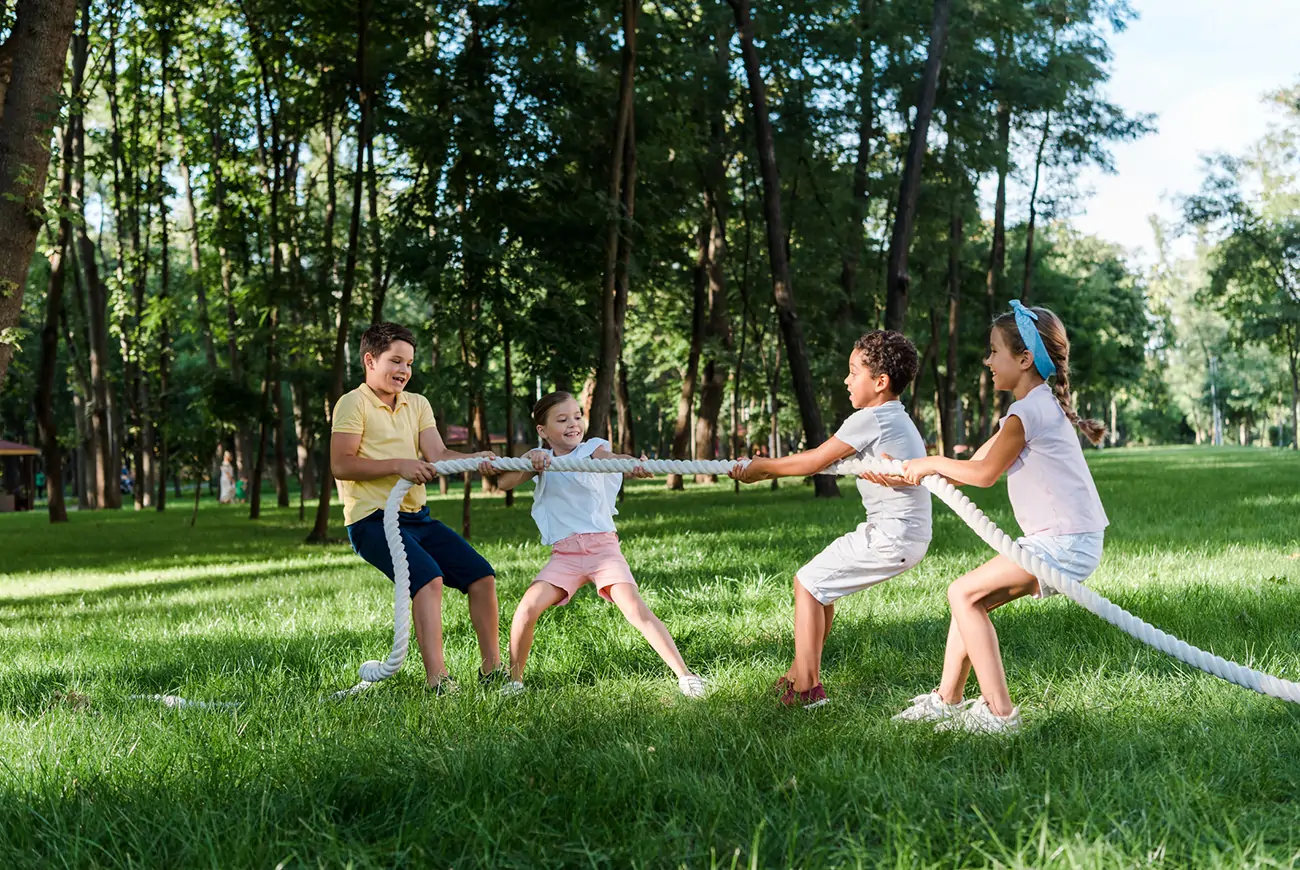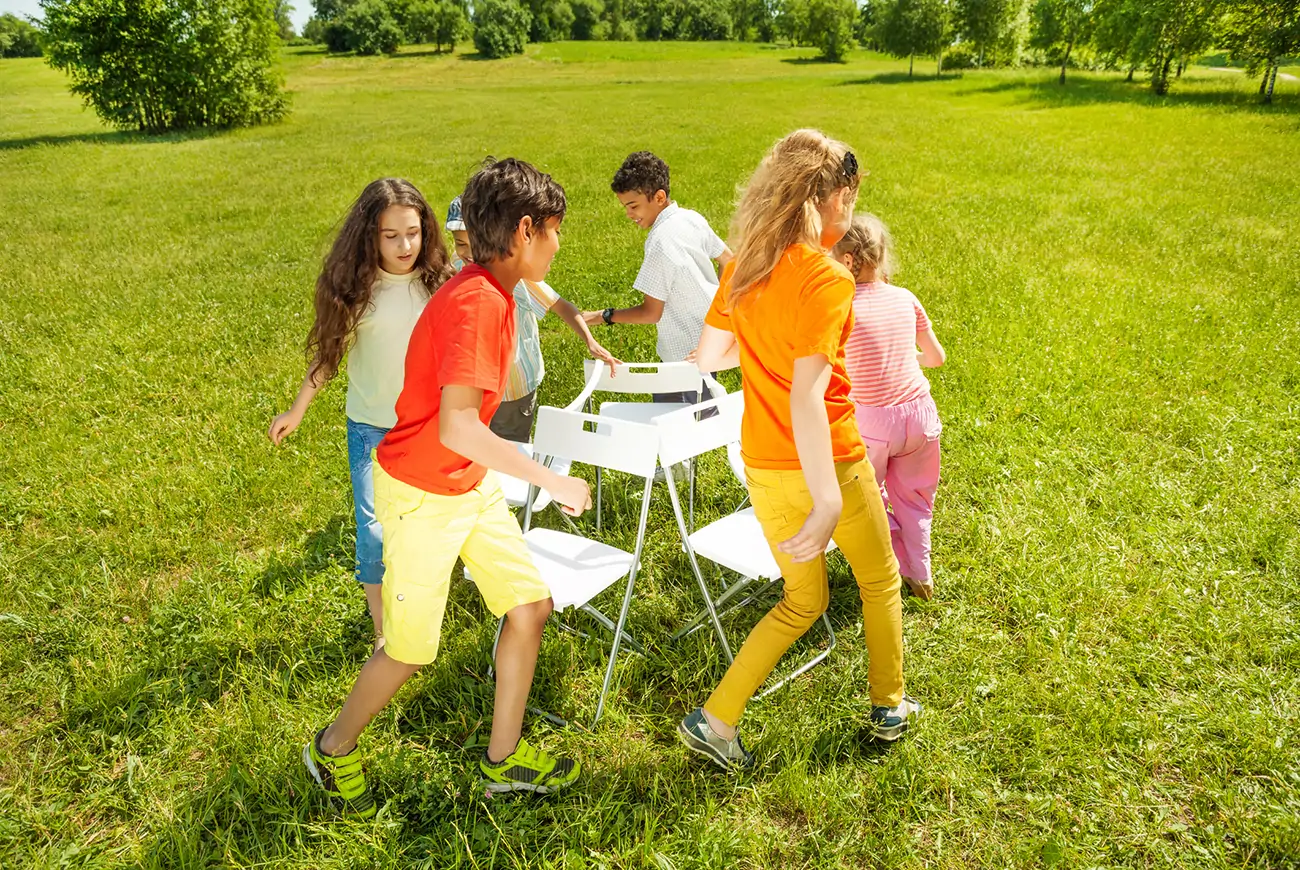15 Traditional Garden Games for Kids
7 min read
Last Modified 22 May 2025 First Added 10 April 2024

With the sun finally shining and little birds chirping, it’s time to officially step outside and enjoy diving into some classic garden games that have been a tool of entertainment for kids throughout the decades. From simple yet engaging games to more challenging activities, here is a list of 15 traditional garden games that will act as a masterclass for skill development.
Draw a hopscotch grid on the ground using chalk (as it can be erased once no longer needed). Each player takes turns hopping through the grid, with an aim to reach the end of the grid without stepping on the lines or losing balance.
Useful development: Kids improve coordination as they hop to the finish line, balance, and can work on their counting skills with each hop.
One player is the ‘seeker’ who must close their eyes and count to an agreed number while other players hide. Once done counting, the seeker tries to find the hidden players, once they have found all players then the seeker has won! However, if the seeker gives up then the hidden players win the game.
Useful development: This game develops kids problem-solving abilities, spatial awareness, and patience.
One player begins the game as “it” and tries to tag other plays by chasing them and tapping them on the shoulder. Once contact is made, the tagged player becomes “it”, meaning they must chase the next player to tag.
Useful development: An active game the utilises speed, agility, and strategic thinking as kids try to dodge one another.

One player stands at the front of all players and acts as the “traffic light”, with their back to the other players. With some distance between the “traffic light” player and other players, when they say, “green light”, players can move forward in whichever way they see fit. When they hear “red light”, all players must freeze as the traffic light player turns around to spot any players moving. If you move while the game is in “red light” then you are out! Win the game by reaching the “traffic light” player without them catching you out.
Useful development: Players must pay attention, improving their listening skills, impulse control, and reaction time.
Players get to pair up and tie one of their legs together with their partner’s leg. Players then race against other pairs to reach the finish line, whichever pair gets there first, wins! Watch all the kids hop to it!
Useful development: A great active game for enhancing teamwork, coordination, and balance.
Set up pegs or posts, some closer than others to increase difficulty, and have players toss rings with the aim to loop them over the pegs or posts. Whoever gets the most rings around the pegs, wins! You can also manage the pegs as a score system, closer pegs count as 5 points while further pegs count as 10, 15, or 20 points.
Useful development: This game develops concentration, precision, and hand-eye coordination.
One play is referred to as “Simon” and has to give commands to all other players starting their sentence with “Simon says.” Players must only follow the commands if they hear “Simon says.” If Simon gives a command without saying “Simon says” first, and a player follow it, then they are out!
For example, “Simon says rub your tummy and pat your head.” All players must follow this. However, if Simon only says, “rub your tummy and pat your head”, then any player who follows this will be out of the game.
Useful development: Kids can focus on their listening skills, attention to detail, and ability to follow instructions.
Players sit in a circle, and one player gets to walk around the circle tapping other kids on the head saying “duck” with each tap. When they tap a player and say “goose”, that player must chase them around the circle to try to tag them before they sit down and take their seat!
Useful development: Kids experience physical play, social interactions amongst players, and anticipation.
Set up a variety of point values (many use hula-hoops for this) and have players take turns tossing bean bags at them. Each point can represent a different score for enhanced difficulty.
Useful development: Kids practice hand-eye coordination, aiming and addition (as they add up their scores and keep track).
Arrange chairs in a circle or back-to-back with one less chair than the number of players. Start playing some fun music and have the players walk around the chairs. When the music stops, players must find a chair to sit in. The player left standing with no chair is then out! Be sure to remove a chair between each round until you are left with one chair and two players for the final battle!
Useful development: Kids can learn agility, quick decision-making and improve on their listening skills.

Divide players into two teams and create a zone for each team that will be that team’s territory, each team has a “flag” hidden in their specified territory. The goal is to sneak into the opposing team’s area, capture their flag, and bring it back to your side without getting tagged by the opposing team. Whoever successfully captures a flag and bring it back to their side, scores a point!
Useful development: Kids can improve their strategic skills, teamwork ability, and stealth.
You can use a long stick or rope as the limbo bar alternative. Players take turns bending backwards to pass under the bar without touching it or falling. When all players pass, the bar gets lowered until there is only one player standing (or bending!).
Useful development: Flexibility, balance, and body awareness.
You can choose to set this up as an individual race or a relay race in teams depending on how many players there are. Players stand in a line holding a spoon and balancing an egg. Players must race to the finish line without dropping their egg otherwise they have to start from the beginning again.
Useful development: Kids enhance their balance, coordination, and patience.

Whether played in teams or individually, players stand in a sack or large pillowcase and have to hop to the finish line. The first team or individual to get to the finish line wins!
Useful development: Coordination (as it is harder than it seems to jump whilst in a sack), balance, and leg strength.
Divide players into two teams with a middle partition clearly distinguished. Teams then must tug on the ends of the rope, trying to pull the other team across the designated line. Whichever team can pull the other across the line wins!
Useful development: Kids built their physical strength, teamwork, and determination.
With this variety of traditional garden games, your garden or local park will become a hub of laughter, excitement, and active play for kids of all ages (adults don’t be afraid to join in!).
Happy playing!
Read our disclaimers.